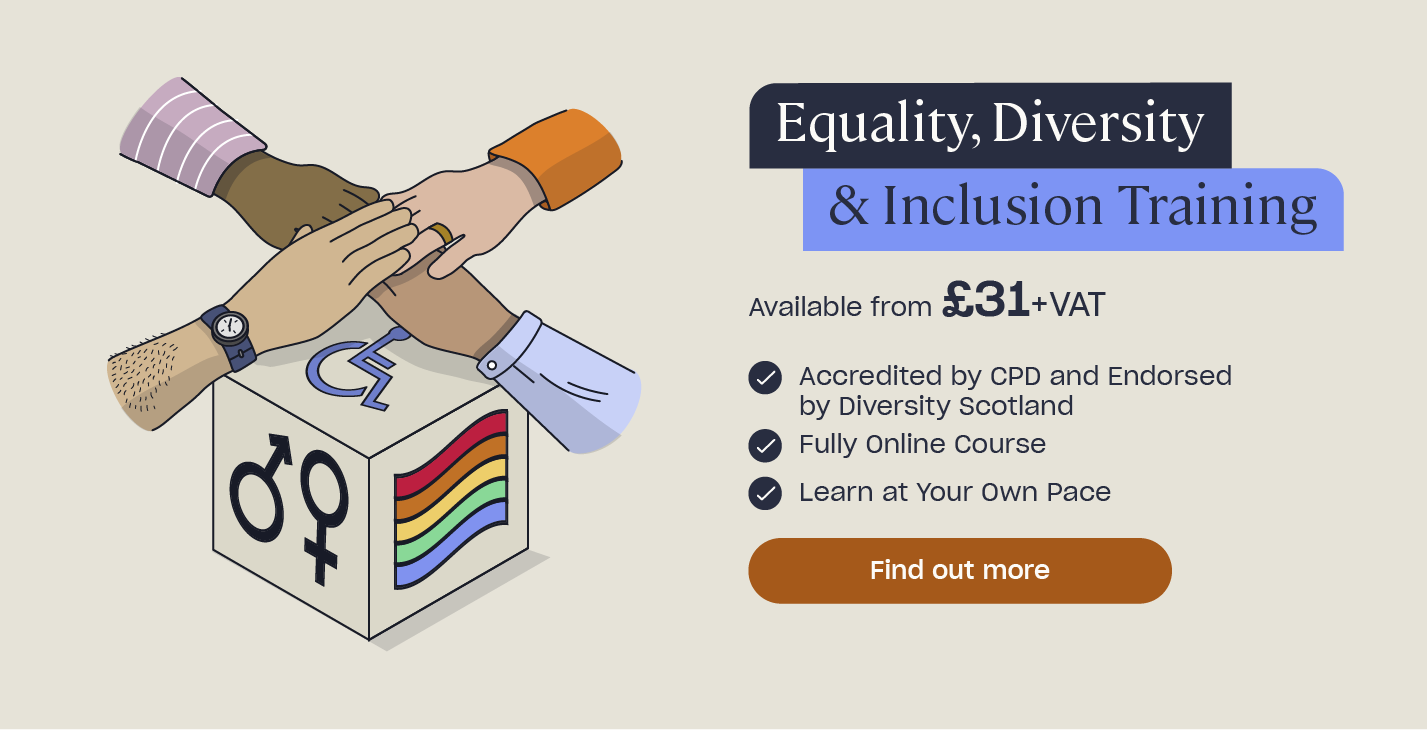What is the Equality Act 2010 and Why is it Important?
Everyone has the right to equal opportunities and to live free from discrimination, victimisation or harassment, regardless of the characteristics they possess. This is why the Equality Act 2010 exists – to ensure that everyone is lawfully protected from discrimination. Equality, diversity and inclusion should therefore be a key focus of all workplace policies and procedures, and throughout society as a whole.
Within this article we will explain what the Equality Act 2010 is and why it was introduced. We’ll also outline different types of discrimination, the nine protected characteristics and the ways in which the Act aims to empower individuals.
What is the Equality Act 2010?
The Equality Act was put in place on 1 October 2010 to ensure people and their rights are lawfully protected from discrimination. Its purpose is to create a fairer society and one that further promotes equal opportunities for all. All workplaces must comply with the Equality Act by law and so it is important to understand what actions and treatment are seen as unfair, which characteristics are protected and ensure an inclusive, diverse, respectful and equal culture is promoted at all times.
There were previously many anti-discrimination laws already in place, however, these are now covered under this one Act, making the information covered within this legal framework much easier to understand. Of the original 116 pieces of legislation now combined within this Act, some of the main ones include the:
- Equal Pay Act 1970.
- Disability Discrimination Act 1995.
- Sex Discrimination Act 1975.
- Race Relations Act 1976.
- Equality Act (Sexual Orientation) Regulations 2007.
- Employment Equality (Religion or Belief) Regulations 2003.

The update in legislation also allowed for better definition and an increase in lawful protection against discrimination in certain circumstances. The Act sets out the different ways a person or groups can be discriminated against, how the law protects against discrimination at work and which characteristics are protected under the Act. We will look at these particular characteristics in more detail in the next section.
Want to Learn More?
Not only is it a legal requirement, but it is also vital that we each play our part, both as individuals and as an employer, in promoting an equal, inclusive and just society for all. Why not take a look at our Equality, Diversity and Inclusion Training Course to increase your knowledge and gain further insights into the topic.
What are the Nine Protected Characteristics of the Equality Act?
Protection against discrimination is not just applicable to working environments – a person is also protected in education, as a consumer, when buying public services, when buying or renting a property and as a member or guest of a private club or association. As well as understanding where a person should be protected, the nine protected characteristics (previously known as grounds) provide clarification on who is protected under equality legislation.
Each of the characteristics are viewed equally; there is no one protected characteristic that could be considered more important than another. It is also important to remember that everyone experiences discrimination differently and for those who possess several of these characteristics, they may be at an increased risk of discrimination and unfair treatment.

The nine protected characteristics are:
- Age.
- Disability.
- Gender reassignment.
- Marriage and civil partnership.
- Pregnancy and maternity.
- Race.
- Religion or belief.
- Sex.
- Sexual orientation.
From the characteristics listed above, you may want to think about if you have ever been discriminated against yourself and for which characteristic? Or, have you ever treated someone unfairly because they possessed different characteristics to you? Sometimes we can be guilty of making snap judgments about someone, and the reasons for this often come from our background, society and culture, stereotypes, and the media’s influence.
To learn more about how and why we can be influenced in this way, take a look at our Unconscious Bias Training Course.
In the following section we will look at what forms discrimination can take and in what kind of circumstances it may be appropriate.

Why Was the Equality Act 2010 Introduced?
The Equality Act 2010 was introduced to create one single legal framework for protecting the rights of equal opportunity and against unlawful discrimination, harassment and victimisation based on someone’s personal, protected characteristics.
The Act states that discrimination can come in any one of the following forms:
Direct discrimination – treating those with a protected characteristic differently to those without. This means treating them less favourably or unlawfully.
Indirect discrimination – having rules, policies or procedures in place that inadvertently place someone with a protected characteristic at an unfair disadvantage to everyone else.
Harassment – treating those with a protected characteristic in a way that is undignified and subjecting them to behaviour that creates an unpleasant and offensive environment.
Victimisation – treating someone who complains about discrimination or harassment in an unfair way.
Associative discrimination – treating someone less favourably because of a protected characteristic of someone they are associated with, such as a family member or a partner.
Perceptive discrimination – treating someone unfavourably or unlawfully because it is assumed that they possess a protected characteristic. This applies whether the assumption about the person is true or not.

Discrimination in the Workplace
A person can be affected by discrimination in many ways at work, such as receiving unjustified differences in pay or unequal access to training and promotion opportunities. Understanding the ways discrimination can occur can help to prevent it.
Whilst all employees are legally protected from inequality in the workplace, there may be certain justifiable situations where discriminating against a person or groups of people can be lawful. For example, the reason behind discrimination in the following circumstances could be justified and therefore lawful:
- If a highly skilled job required a set number of years experience to ensure the appropriate health and safety standard was met, a woman who was unable to meet that criteria due to the time she required off when having children could, on the surface, appear to be indirect discrimination.
- A Sikh who was banned from wearing a kirpan (ceremonial dagger) whilst working in a high-security mental health facility could be seen to be discriminated against due to their religious beliefs. However, this again could be justified as wearing such an item could pose a serious risk to health and safety.
- Finally, a job role that requires tests to determine a high level of fitness and strength, may employ a younger demographic of people based on their results. This could be seen as age-related discrimination, but the nature of the role may be able to justify such recruitment.
In the majority of cases, however, discrimination is not lawful and all organisations should embrace and empower equality, diversity and inclusion and promote inclusive communication in the workplace.

How Does the Equality Act Empower Individuals?
As with all legislations, the very nature of having legal protection can empower people to embrace their rights. In the case of the Equality Act, it can help give people the confidence to be their full selves, not accept unfair treatment and to feel more in control of their own lives and choices.
Knowing you cannot be refused, ill-treated or rejected because you possess certain characteristics can embolden people to see themselves as an equal, ask more questions, take on new challenges and seek out a wider range of opportunities. Having robust equality, diversity and inclusion policies in the workplace is an excellent way for a business to show its support for such individuals.
It is important to remember that we can all too easily become disconnected from the meaning behind protected characteristics. When we talk of being treated equally and not discriminated against because of them, we should remember that these characteristics stand for who a person is, who they choose to love and what they believe in.
Everyone has the right to be true to themselves, live authentically and be free from judgement and penalty both in their personal and professional lives. The Equality Act aims to protect and empower individuals for these reasons.

The impact of the Act can be far reaching and not only promotes dignified and anti-discriminatory practices within the workplace for those in employment, but it also encourages organisations to take positive action to actively seek out and employ qualified individuals who have certain protected characteristics. This kind of action is legal if it meets certain criteria, particularly in cases where there is underrepresentation within the business.
This in itself empowers individuals, as it increases opportunities for employment and personal and professional development. In cases where training is offered to help those with a protected characteristic develop, this shows a proactive approach and positive action to empower them and to help them overcome any disadvantages they may face compared to other employees.
We are all individuals and in modern society there is a greater need for more inclusive communications and diversity in our workplaces and within our communities. The Equality Act 2010 offers lawful protection against discrimination based on protected characteristics and aims to empower individuals and foster a more equal and fair society. We all have a part to play in making this a reality for all.
Further Resources:
- Equality, Diversity & Inclusion Training
- Equality, Diversity and Inclusion Policies in the Workplace: Free Template
- How to Promote Equality, Diversity and Inclusion in the Workplace
- Equality & Diversity Quiz
- Cross Cultural Awareness Quiz







